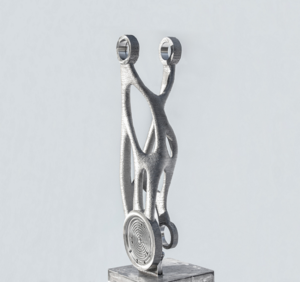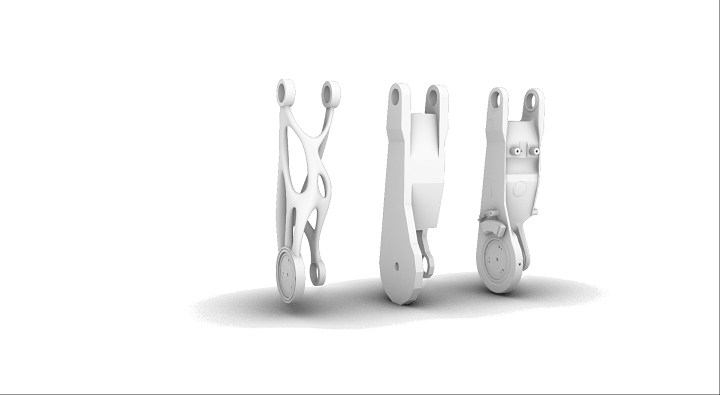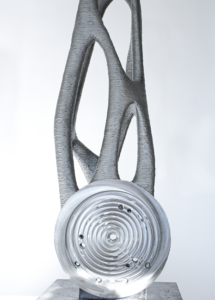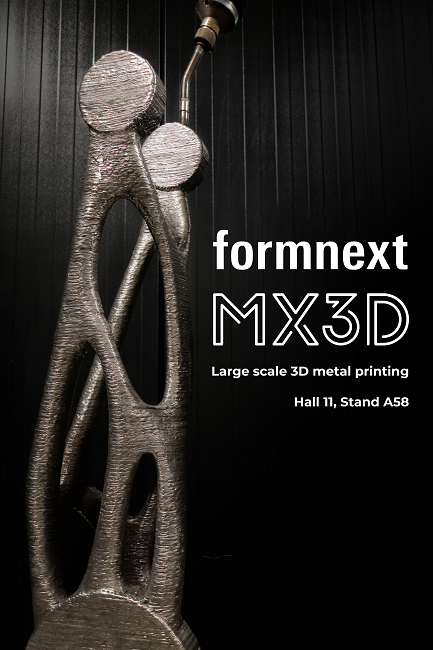3D printing specialist MX3D has been working on a metal AM technology to create large items, such as bicycles and bridges, using robots. Now, the Dutch startup has partnered up with global technology company Altair to print an optimized industrial robot arm for an ABB robot, out of stainless steel, using an advanced version of its Wire Arc Additive Manufacturing (WAAM) technology.
 The goal of the project, which shows how using a digital twin and generative design customization can help “increase productivity for tailored robotic applications,” was to highlight how large-scale metal 3D printing could be used to customize, and optimize, a robot arm for specific operational requirements.
The goal of the project, which shows how using a digital twin and generative design customization can help “increase productivity for tailored robotic applications,” was to highlight how large-scale metal 3D printing could be used to customize, and optimize, a robot arm for specific operational requirements.
Additionally, the partners wanted to show that it was possible to manufacture customized equipment replacement parts, which reduces lead time; a boon for equipment sellers and manufacturers looking to keep things in-house.
“We’re getting much interest from corporates to print large-scale heavy equipment parts. This is either for R&D purposes, low volume production or in case a critical part breaks down unanticipated and need to be replaced fast. MX3D is able to print these parts reliably and fast with WAAM technology. Moreover, the business case improves even further if an optimized design of the part is printed,” said the Project Lead Thomas Van Glabeke, a Technical Business Developer at MX3D. “Altair’s software enables these optimizations via generative design customization. For the robot arm we printed, more than half of the original weight was eliminated due to the optimization while taking into account printing constraints. A great accomplishment!”
Altair engineers used Generative Design Customization to come up with the most efficient shape for the 3D printed robot arm, which would help it provide increased productivity and excellent operational performance. Generative design was also used to develop new designs that featured, as am MX3D press release states, “geometric efficiencies derived from the topology concept.” These designs were later compared and validated based on manufacturing feasibility and performance.
The Digital Twin Design process was used to help optimize the stainless steel robot arm for handling higher precision and build rates, in addition to lower kinetic energy. The process used kinematic motion simulation of assemblies to complete performance requirement identification.
“We are thrilled to collaborate with MX3D and are proud to contribute to its vision of developing tailored robotics. The challenge in this showcase was particularly exciting as our Altair team supported the robot customization redesign from the earliest stages, helping to identify requirements for optimal operational conditions with a digital twin representing the entire system,” said James Dagg, CTO, Modeling and Visualization, at Altair Engineering. “We are looking forward to seeing the project progress as our efforts help to increase MX3D’s productivity.”
MX3D’s WAAM technology uses advanced geometry processing, which means that complex organic geometries can actually be 3D printed upright. To make sure that maximum efficiency is used to build the part, the process also uses intelligent algorithms to find the best toolpath direction and print strategy for every single geometry feature. The original robot arm weighed 150 kg, but thanks to all of the partners’ hard work, the 3D printed one only weighs 73 kg – an impressive material weight reduction of over 50%. Additionally, if 3D printing continues 24 hours a day, the part can be completed in just four days, only requiring a 3-axis milling machine to finish the robot arm.
Altair’s Mirko Bromberger, Jaideep Bangal, Tony Gray, and Michael Wawrzinek were in charge of design and engineering for the project, while van Glabeke, Richard van Dam, Cas Nieuwland, and Max Peek took care of the 3D printing piece of the equation. Martin van der Have and Gino Seesing from ABB – a top supplier of industrial robots and robot software, equipment, and complete application solutions – were in charge of the project’s robotics aspect.
“ABB Robotics is a proud supporter of MX3D and we are happy to support this business case,” stated van der Have, the Sales & Marketing Manager for ABB Robotics in the Benelux region. “We believe that new technologies like rapid manufacturing will add new possibilities within the market of industrial robots. This could be spare parts, cover plates, construction parts of other unique parts needed to complete the mechanical construction of a production robot. Let’s write the future of robotics. Together.”
Many new markets, such as Heavy Industrial Equipment industries, are starting to adopt industrial robots. Using WAAM technology to build a large-scale robot arm is a great example of how industrial robots can really benefit this particular sector. Now that the robot arm has been successfully 3D printed, ABB, Altair, and MX3D plan to reassemble the complete robot.
Speaking of MX3D, the company recently released MetalXL, a basic version of its software that helps users 3D print large metal objects in-house. Several users are currently testing MetalXL Beta\01 for MX3D, and more customers will have the chance to try out an advanced beta version in Q1 2020. MetalXL beta software will be officially launched by MX3D at formnext this week – learn more at Booth A58 in Hall 11. You can also visit Altair at formnext – Booth E11, Hall 11.1 – to learn more about its software and other solutions.
[Image credits: Merlin Moritz and Thomas Van Glabeke]Discuss this story and other 3D printing topics at 3DPrintBoard.com or share your thoughts in the Facebook comments below.
Subscribe to Our Email Newsletter
Stay up-to-date on all the latest news from the 3D printing industry and receive information and offers from third party vendors.
You May Also Like
Further Understanding of 3D Printing Design at ADDITIV Design World
ADDITIV is back once again! This time, the virtual platform for additive manufacturing will be holding the first-ever edition of ADDITIV Design World on May 23rd from 9:00 AM –...
3D Printer Maker EVO-tech Reborn as NEVO3D — Once More With Feeling
EVO-tech was a 3D printing service and original equipment manufacturer established in 2013 and based in Schörfling am Attersee, Austria. The company produced high-quality material extrusion systems featuring linear bearings,...
3D Systems Brings 3D Printed PEEK Cranial Implant to the U.S. with FDA Clearance
For more than 10 years, 3D Systems (NYSE:DDD) has worked hand-in-hand with surgeons to plan over 150,000 patient-specific cases, and develop more than two million instruments and implants from its...
CDFAM Returns to Berlin for Second Annual Symposium
The second CDFAM Computational Design Symposium is scheduled for May 7-8, 2024, in Berlin, and will convene leading experts in computational design across all scales. Building upon the first event...





































